|
< Earlier Kibitzing · PAGE 3 OF 3 ·
Later Kibitzing> |
| Oct-01-10 | | ughaibu: TheFocus: that's very interesting, Lasker's note to move 18, blocking the f-file is the last thing that I'd think of. |
|
| Jan-25-11 | | Llawdogg: What a rook! 15 ... Re5! sort of changed the energy of the game. Then, after a lot of maneuvering, 27 ... Rxf4!! defeated the strong-looking pawn fork and won the game. Lasker was something else! |
|
| Jun-17-12 | | backrank: < igiene: I don't understand why commentators and people in general are so conditioned by game result. Lasker's success is correlated to his enormous strenght as a tactic and to Tarrasch's mistakes in this game. A move like 16..Rc5 in 99 out of 100 cases will end in disaster because Rook is too much exposed in the fourth rank. I think that is very dangerous for intermediate player to think that such a move will work in similar cases.> I agree with your last statement. No one of us can afford playing like Lasker. (The same, of course, is true, if we replace Lasker by any other great player.) But isn't it exactly that what makes such games so fascinating? Lasker CAN afford playing like this - and he wins positions anyone else would lose. Réti (in 'Modern Ideas in Chess') comments on this game: 'What is it, we may well ask, in this game that pleases us so much. The layman who plays it through without any enlightenment will at most derive some interest from the surprise move 27. ... Rxf4. But the expert will with very great tension follow Lasker's equally original and deep idea of placing his rook upon seemingly perilous ground in order to extricate himself from his congested position. And we experience a desire that this bold stroke of genius and not the sober prosaic method will snatch a victory. We see how Tarrasch, the man of method, closes in the rook that has been forced through. We were just on the point of giving up Black's game as lost. It was black who had our sympathy. But then comes a surprising move 23. ... Rd8; with the threat of liberating the rook and breaking up White's position, and then again White's counter combination. The drama approaches its climax. And then when the solution comes, 27. ... Rxf4, great is our delight that the miraculous has really come to pass and that the idea of a genius, for which every pedagogue would have foretold a bad end, has triumphed over all that was systematic and according to rule.' No one can play like Lasker, but no one can write like Réti! |
|
| Jul-23-12 | | King.Arthur.Brazil: In a middle of complex combination, in my opinion,TARRASCH commited the little fault 29.Kh1, when if 29.Kf1 Qb1+, the answer would be 30.Te1! For this reason, I guess that the reply would be 30... Rd2 31.Re2,with the difference that K now is in the center. |
|
| Dec-17-14 | | MindCtrol9: This match is more than a proof how strong Lasker was beating S Tarrash so easily.I really love his games especially when he maneuvers the Knights.With his games anybody can learn to play a great chess.I learnt with a Tarrash book which was excellent.Nevertheless, Lasker showed theory has to be applied in a real game.It is amazing how good Lasker and many others were, and the most important thing:only using their brains which made players from the recent past superior to any actual player. Now is more based on computers analysis and less creativity.My point of view. |
|
| Mar-09-15 | | kevin86: At one move, Lasker had both rooks and queen under fire from pawns...then he queens a pawn himself! |
|
| Jul-22-15 | | RookFile: 20 years ago, folks would have said: "Imagine playing the Ruy Lopez Berlin... how quaint!" |
|
| Jul-22-15 | | mruknowwho: Black wins by polygamy. |
|
Jul-22-15
 | | Honza Cervenka: It seems to be that Tarrasch not only missed 27...Rxf4!, which refutes his combination. In fact, black has several perfectly playable alternatives, which keep equality at least. For example, 27...bxc3 28.exf6 c2 29.Re8+ Kh7 30.Nxd6 c1=Q+ 31.Qf1 Rc2 with threat Qd2 gives white no advantage at all. The game can continue 32.fxg7 Kxg7 33.Re2 Qb2 34.Nf5+ Kf6 35.Rxc2 Qxc2 36.Nxh6 Qxa2 37.Qb5 Nd5 38.Qxb7 Qa1+ 39.Kg2 Qa2+ and now if white tries to avoid repetition of moves (perpetual check) by playing 40.Kh3, then black can play 40...Nxf4+! and 41.gxf4? loses for 41...Qb3+ 42.Qxb3 axb3 etc. Another playable possibility of black in the 27th move seems to be 27...Qg6 28.exd6 [28.f5 Rd1+ (28...Rf6!? looks interesting too) 29.Qxd1 Qxf5 30.Nd6 Qg4 and black keeps some edge] 28...bxc3 29.Nxc3 (What else? Of course, 29.Rxc3?? cannot be played for 29...Qb1+ and 30...Qxb5) 29...Qxd6 30.Qxb7 Qc5 31.Qb8+ Kh7 32.Qe5 Qxe5 33.fxe5 Nd7 34.Ne2 Rc5 35.e6 fxe6 36.Rxe6 Rc2 with some initiative in ending. Also 27...Qd8 seems to be playable as after 28.Nxd6 Rc6 29.cxb4 Nc4 30.Nxc4 Rxc4 31.a3 Rc2 threats of active black pieces are sufficient to force draw. |
|
| Jul-22-15 | | john barleycorn: <Honza Cervenka> thanks much appreciated |
|
| Jul-22-15 | | kevin86: Brilliant win by the champ! |
|
| Jul-22-15 | | McLain: <keypusher> Thank you ! Excellent ! |
|
| Jul-18-23 | | generror: Oh boy, this loss must have been hard for Tarrasch, finally playing his arch-enemy in the first game. Which probably explains why he didn't resign after <29...Qb1+>, but played on until he reached a respectable move 40. Once again, one can only marvel at Lasker's play, finding the <...Re5-c5> maneuver and of course that amazing <27...Rxf4> which must have come as a shock to Tarrasch, who probably couldn't believe his luck that Lasker fell for his little trap. |
|
Jul-30-23
 | | KEG: Kasparov calls this "the fatal fourth game" of the Lasker-Tarrasch match which "undermined 'Tarrasch's] confidence in his powers." And indeed, the way in which Lasker converted what Tarrasch believed was a dead-lost position for Black into a dynamic powder-keg which blew up in Tarrasch's face must have been shocking. But, as <keypusher> has ably argued, to consider this fourth game as the turning point in the match overlooks the incontrovertible fact that as of 1908 Lasker was a far superior chess-player. More important than the effect on the match score is the quality of the game. Until Tarrasch 's second-best 24th and 25th moves, this was a superb display of chess tactics and positional play. My teacher Susan Polgar calls chess at its best a "battle of ideas," and that is precisely what is showcased here. Lasker, as demonstrated in his brilliant victory in Game #1 of his match with Marshall, had a profound understanding of the horizontal powers of the Rook. This understanding is exemplified by Lasker's marvelous winning combination after Tarrasch's blunder on move 26, but--and perhaps even more magnificently--by Lasker's 15th and 16th moves in which he brought his Rook to the center of the board in derogation of what Tarrasch (and no doubt just about everyone else) apparently believed was the proper manner of deploying Rooks. This culminated in the winning 27...Rxf4!, a move that must have shocked Tarrasch to his core. 1. e4 e5
2. Nf3 Nc6
3. Bb5
The fifth consecutive Ruy Lopez in the match. This game followed the moves of Game #2 through White's 8th move. 3... Nf6
Tarrasch played 3...a6 in Games 1, 3, and 5. Lasker played 3...Nf6 in each of the five times he played the Black side of the Ruy Lopez in this match, winning twice (Games 2 and 4), losing once (Game 10), and drawing the other two times (Games 8 and 14). 4. 0-0 d6
5. d4 Bd7
6. Nc3 Be7
7. Re1 exd4
8. Nxd4

click for larger view8... NxN
Lasker had played 8...0-0 in the second game of this match here, and there of course is nothing wrong with that move (which, as Kasparov had pointed out, was used by Lasker in his later matches against Janowski, Schlechter, and Capablanca. Perhaps Lasker in this game wanted to avoid any preparations by Tarrasch. 9. QxN
Tarrasch later said that the text was superior to 9. BxB+ NxB, and Kasparov said that the position resulting from the Bishop exchange is "equal." Other than stylistic considerations, I see little to choose between 9. QxN and 9. BxB+. In either case White is slightly better developed and thus slightly better. Soltis claims that 9. BxB+ is "inexact" because of 9...NxB 10. QxN Bf6 [10...0-0 looks simpler for Black--KEG] 11. Qb4 BxN [Soltis assigns this an "!"] 12. QxN "with a solid game." But here Black is virtually forced to play 12...0-0 after which White is plainly (albeit slightly) better with 13. Be3 or 13. Bf4. 11...b6 looks like an improvement for Black in Soltis' line, but even then White has (somewhat) the better of the opening. The simple conclusion is that both 9. QxN and 9. BxB+ have their points and to call one or the other a mistake of any kind looks wrong. 9... BxB
So the Bishops get exchanged anyway.
"...trading pieces helps Black because 9...0-0 10. Bf1 [Better still would be 10. Bc4--KEG] allows White to make better use of his spatial edge..." (Soltis) 10. NxB 0-0
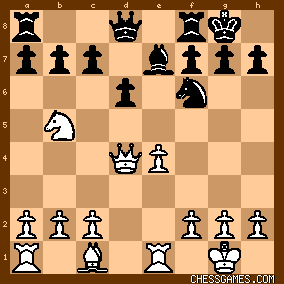
click for larger viewWhite is a bit better, but hardly significantly more than would have been the case after 9. BxB+. The extent of White's advantage has been debated by the commentators. The actual contestants emphasized White's edge: "White has a very free game and is several tempi ahead." (Tarrasch) "Black is cramped for space while White enjoys a very comfortable and aggressive development. The only advantage for Black is to be able to avoid any loosening of the Queen's-wing." (Lasker) My feelings, however, are more in line with:
"The White Knight is not doing much good at b5 [If 11. Nxa7? c5---KEG], and the position looks quite level." (Wilson) An overstatement perhaps, since White is surely for choice here [Fritz (0.23); Stockfish (0.25), but no more so than those claiming any major advantage for White. |
|
Jul-31-23
 | | KEG: Post II
11. Bg5
"Dr. Tarrasch likes to develop this Bishop to b2 in the Ruy Lopez, but, as Mr. Teichmann has pointed out, there is no time for this in the present position as Black would play Nd7 [after 11. b3] followed by Bf6." (Wilson) In the event of 11. b3 11...d5 might be even better than Teichmann's admittedly strong move. Both Schlechter and later Kasparov have considered 11. Bf4 which seems about as good as the text. Capablanca's suggested 11. Qc3 accomplishes little not so much because of Kasparov's 11...a6 but because of 11...d5! which fully equalizes. White can also retain his small superiority with the simple retreat: 11. Nc3. 11... h6
12. Bh4 Re8
This Rook, which was soon to become the principal actor in the drama to follow, prepares to enter the fray. Kasparov's idea of 12...Ng4 (which he assigns a "!?") doesn't look that great after 13. BxB QxB 14. Rad1. After 12...Re8, the position was:
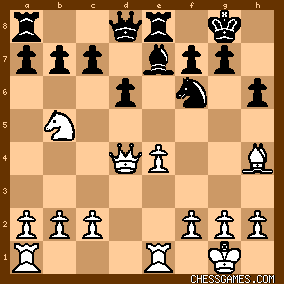
click for larger view13. Rad1
"White is fully developed and threatens to win by 14. e5." (Lasker)(see Tarrasch and Kasparov, similarly). 13... Nd7
Lasker called this "the only move," but 13...a6 looks simpler and better. The game would then likely continued 14. Nc3 c6 allowing the Black Queen to become involved via a5 or c7. The text, however, does have the merit of precipitating the trade of Bishops which, however, did not solve all of Black's problems. 14. BxB RxB
Ste-by-step, this heroic Rook begins to make its presence felt: 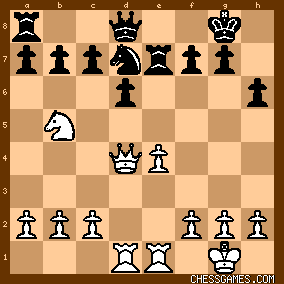
click for larger view15. Qc3
"!?"--(Kasparov)
"Threatening to redeploy the Knight with tempo via d4 to f5, with a mate threat on g7." (Tarrasch) "Immediately threatening the c-pawn, to say nothing of the menacing push of the e-pawn as well as the very aggressive Night maneuvers such as Nd5...f5." (Lasker) Hoffer called Tarrasch's plan "loss of time," while acknowledging the force of the intended Knight redeployment. 15. c4, as played in the 4th game of the Capablanca-Marshall 1909 match, led to a draw after 14...Re6 16. f4 a6 17. Nc3 Nf6 18. Nd5, but White was surely better, and 18. b3 first looks like an improvement. Much ink has been spilled over the merits of 15. f4 here, but after 15...a6 16. Nc3 Nf6, White's advantage, if any, is surely minimal. After 15. Qc3, the position was:
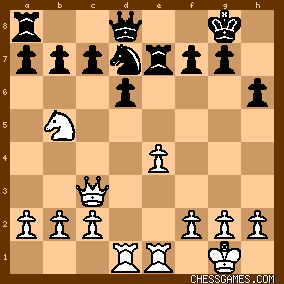
click for larger viewAs noted above, Tarrasch had his plan in mind and seemed poised to unleash a classic Tarrasch positional crush. How best should Lasker had met the threats he faced? "What makes this stage of the game remarkable is the way Lasker finds a way to turn his opponent's attention away from [his] plan. Today's players...would look for other ways to change the subject--by sacrificing a pawn or the exchange..." (Soltis) But, as will be seen, Lasker had something completely different in mind. What followed is...even over a century later...breathtaking to behold. To paraphrase Kasparov, Lasker had to do little less than reinvent chess theory to counter Tarrasch's formidable plan. The computers, of course, spot this in a nanosecond. But for us mortals, Lasker's idea of how to utilize his e7 Rook remains as shocking for us today as it must have been for Tarrasch when he faced Lasker's amazing conception over the board. |
|
Jul-31-23
 | | KEG: Post III
15... Re5!
"!"--(Lasker)(Kasparov)(Soltis)(Schroeder)
"A clever indirect defense of the c-pawn, for the time being." (Hoffer) "The saving grace." (Lasker)
"...a brilliant way of defending the c7-pawn." (Kasparov) "Now begins that series of maneuvers with the Rook in which Dr. Lasker makes his attack on the Q side and in which Dr. Tarrasch tries to entrap this piece which have made the game famous." (Wilson) Tarrasch, not surprisingly, gave the move mixed reviews: "Black has a difficult defense; the rook move leads in the end to the misplaying of this piece..." Kasparov, like Tarrasch, thought Lasker was in at least potential trouble. But <keypusher> provides a wonderful corrective analysis which appears in his post with which I entirely agree. I strongly suggest reading this analysis which places the move in context and shows that Lasker was not "hanging on by his fingernails." Interestingly, Lasker's move was not the only good choice. He could equally well--from an objective perspective--have played 15...Nc5. While, as Tarrasch has persuasively argued, White could then have retained some advantage with 16. f3, but then Lasker had numerous plausible and safe responses, including 16...Qd7 as discussed by Tarrasch, but then after 17. Nd4, Lasker need not have played 17...Ne6 as given by Tarrasch's commentary but instead 17...Re5 or (perhaps better still) 17...Na4. In any case, let's have a look at the position after Lasker's 15...Re5: 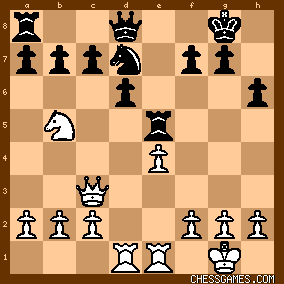
click for larger view16. Nd4!
"!"--(Kasparov)(Soltis)
"For the moment, Tarrasch is equal to the occasion: he threatens Nf5 and f4" (Kasparov) The commentators are unanimous that 16. Qxc7 would have been a mistake. There is, however, some tweaking of the analysis to be considered: 16. Qxc7 Rxb5 17. Qxd6, but here they all give 17...Rxb2 which leads to an approximately equal game. But they all miss the strength of an immediate 17...Rc8 [a move Kasparov reserves for after 17...Rxb2 18. QxN QxQ 19. RxQ Rc8, overlooking that in this line White can improve with 18. e5] 18. QxN QxQ 19. RxQ and only now 19...Rxb2 leaving Black very much for choice. Of course, 16. Nxc7?? would, as noted by Kasparov, lose instantly to 16...Rc5. So let's have a look at the position after Tarrasch avoided the above pitfalls and played the very strong 16. Nd4z; 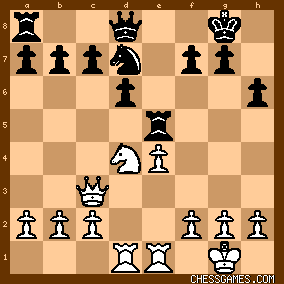
click for larger view16... Rc5
"!"--(Kasparov)(Soltis)
Tarrasch called this move an "evil choice" and contended that 16...Nf6 was much better. And, indeed, 16...Nf6 is absolutely fine as <keypusher> reports Shredder agrees. And Soltis' 16...Nc5 (Kasparov notwithstanding) is also excellent and probably as objectively good as the text or 16...Nf6. But Lasker's 16...Rc5, while seemingly hazardous, was in fact entirely sound, as subsequent play and analysis confirms. "The Rook must be dangerously exposed so as to draw the brunt of the attack." (Lasker) And there was also a psychological factor:
"...from the purely positional viewpoint this move is very dangerous: the stray rook may cause Black significant problems, but...the impudent behavior of the rook is bound to upset the opponent's composure." (Kasparov) Fritz gives approximately equal value to Lasker's move as compared with 16...Nc5 and 16...Nf6. Stockfish prefers 16...Nf6. But whatever the appearances, Lasker's move can not be called any sort of mistake. It left the position after 16...Rc5 as: 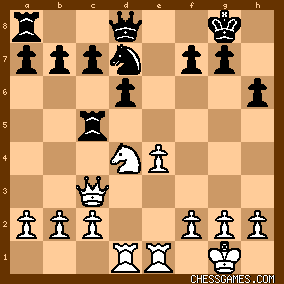
click for larger view |
|
Aug-01-23
 | | KEG: Post IV
17. Qb3
"White immediately makes an attacking move, so as to take away the rook's retreat with f2-f4. The encirclement of the rook is now the leitmotif of the whole game. The previously planned attack on the king with Nf5 and Qg3 is immediately abandoned, as Black could easily ward it off with ...Qg5 or ...Rg5." (Tarrasch as per <keypusher>) As Kasparov and Soltis have pointed out, 17. Qg3 would allow Black to equalize with 17...Qg5. 17... Nb6
This, as Tarrasch notes, guards the Black b7 pawn and supports Black's c5 Rook. In fact, Lasker called this "the only move." But also is good is Karparov's 17...a5 which also protects against 18. Qxb7 (which now would allow 18...Rb8 followed by 19...Rxb2). Now Tarrasch faced an important decision, the position now being: 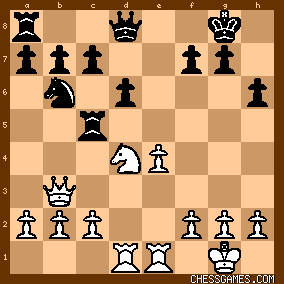
click for larger view18. f4
"!"--(Tarrasch)
"Tarrasch carries out the obvious plan of trapping Black's Rook." (Schroeder) "Beginning the shutting in of the Rook." (Wilson) "Cutting off the Rook's retreat." (Kasparov)
The move, however, was double-edged:
"Useful in laying siege to the Black Rook, but the move has the drawbacks of weakening e4 and blocking the f-file for the White Rooks." (Lasker) Tarrasch himself conceded that his move "loosened" his position "a little bit." On balance, the move looks best for the reasons spelled out by Mark Dvoretsky which are quoted here in full by <keypusher>. 18... Qf6
18...Qh4 was also good for Black. The text left: 
click for larger view19. Qf3
By this point, Tarrasch had apparently become fixated on his notion of trying to trap the White Rook and ignored alternatives that might have strengthened his position: e.g., 19. Re2; 19. g3; 19. Qg3. The problem with the text was that it allowed the equalizing 19...Na4 (much better than Lasker's later idea of 19...a5). 19...Na4 has been nicely analyzed by Mark Dvorersky. Once again, <keypusher> has provided us with Dvoretsky's thinking. But Lasker had other ideas: 19... Re8
"?"--(Kasparov)
Kasparov has hypothesized that Lasker here was tempted by a trap into which Tarrasch might have fallen into with 20. b3? (which allows the powerful retort 20...Nd5! after which Black would have the edge. But Tarrasch was not one to fall into this sort of nonsense, and instead played: 20. c3
"!"--(Kasparov)(Soltis)

click for larger view"Not losing his presence of mind." (Kasparov)
"This stops 20...Nd5 and anticipates 20...Na4 21. Re2"--(Soltis) There were, of course, alternatives to the move so lauded by Kasparov and Soltis, such as 20. g3 or 20. Re2 which also cut down Black's options. 20... a5
"!"--(Kasparov)
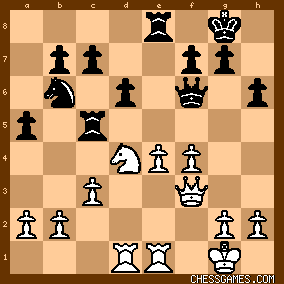
click for larger view"To the aid of the Rook." (Kasparov)
Tarrasch and Hoffer both called this an "ingenious maneuver" is a bid to free Black's c5 Rook. The game now became exceptionally complicated. While even after the text White was theoretically better, the tactically charged position played into Lasker's strengths. Both sides now had complex combinations in mind. But though Tarrasch's ideas were clever, he ultimately faltered when it turned out that Lasker had seen a bit deeper. |
|
Aug-02-23
 | | KEG: Post V
21. b3!
"!"--(Soltis)
"The right retort and the refutation of Black's freeing attempt..." (Tarrasch as per <keypusher>). Saying this move "refuted" Lasker's 20...a5 was a gross overstatement, but the praise of 21. b3! was spot on. "So far White has refused to be sidetracked into trying the trap the Rook with ideas like 21. Nb3 Rb5 22. Qe2 [White would still retain some edge in this line with 22. Qd3; 22. g3; or 22. Re2--KEG] Rf5! [here Soltis missed the response I am sure would have been forthcoming from Lasker: 22...Rd5! which would completely equalize--KEG] 23. g3 a4 [23...g6 here is much better than Soltis' move] 24. Nd4 [??-in this flawed line from Soltis, White could have played the much stronger 24. e5! with a significant advantage--KEG] Rc5. [At the end of Soltis' analysis, White retains some edge, but this means little given the previously identified errors (quite surprising given the general excellent of Solti's book on Lasker--KEG]. Kasparov considers the alternative 21. Qd3, but his analysis overlooks the seemingly obvious 21...Qxf4. Anyway, back to the actual game after Tarrasch's excellent 21. b3. which left the position as follows: 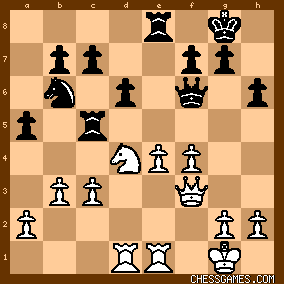
click for larger view21... a4
21...Qg6, a move not discussed by any of the commentators I have consulted, looks simpler and better. 22. b4
22. Keeping the Rook still shut in, his original intention." (Hoffer) 22. c4 was arguably better for the reasons given by Tarrasch, Kasparov, and <keypusher> and quoted at length in the latter's excellent post. But I agree with Tarrasch (again, see the post by <keypusher> that both 22. b4 and 22. c4 were strong [Stockfish gives the edge to 22. c4 while Fritz gives the edge to 22. b4]. The text was "in no way mistaken" (Tarrasch) and was most certainly not the reason Tarrasch lost his small advantage and later the game. Soltis assigns 22. b4 a "?" based on "practical" considerations, but concedes that--objectively--both moves give White a "small edge." 22... Rc4
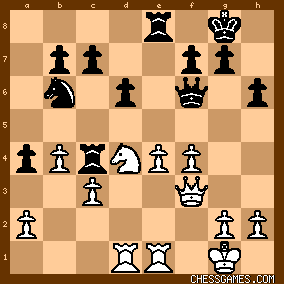
click for larger view"Although the Rook is trapped, it is exerting constant pressure on c3, so that it is now doing some work." (Kasparov) 23. g3
"Wishing to keep the f-pawn covered in anticipation of the push of the Black c-pawn"--(Lasker) "In order to execute his plan White must secure the f-pawn." (Schroeder) "The f-pawn is strengthened, not only to release the Queen from defending if, but also for other eventualities. For instance, an attempt at the release of the imprisoned Rook with d5 at an opportune moment." (Hoffer) "White is prepared for the anticipated c7-c5 advance; if he were to play an indifferent move instead of 23. g3, Black could free his Rook with 23..c5 24. Nb5 d5 25. exd5 Rxe1+" (Tarrasch as per <keypusher>). While the text is fine, the balance of Tarrasch's analysis is flat out wrong. If, for example, 23. a3, Black could not afford 23...c5? in light of 24. Nb5 d5 25. e5! rather than Tarrasch's lame 25. exd5 which allows Black to equalize easily. Hoffer suggested 23. Re3, but that allows Black off the hook with 23...a3. In any case, after 23. g3, the position was:
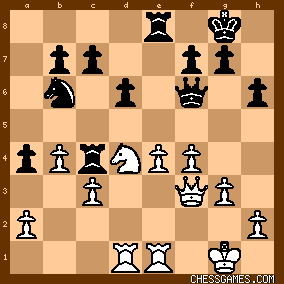
click for larger viewNow, the competing ideas came to a head, as did the resulting fireworks. |
|
| Aug-02-23 | | Olavi: <KEG: Kasparov considers the alternative 21. Qd3, but his analysis overlooks the seemingly obvious 21...Qxf4.> It's s 21.Nb3 Rb5 22.Qd3 - a typing error. |
|
Aug-03-23
 | | KEG: <Olavi>You are correct. With regard to my comments about "21, Qd3," I was indeed misled by a misprint in Kasparov's book. The intended line was probably the one you mention (21. Nb3 Rb5 22. Qd3). Focusing on that variation, best for Black is now 22...Rh5 with about equal chances. But none of this detracts from Tarrasch's well-reasonsed 21. b3. |
|
Aug-03-23
 | | KEG: Post VI
23... Rd8?
"!"--(Lasker)
"Black defends the d-pawn in preparation for c7--c5." (Tarrasch) "Preparing c5..." (Kasparov)
"Black prepares c5 which he couldn't play immediately because of 24. Nb5!" (Soltis) "He prepares to answer Nb5 with c6" (Schroeder)" "Having failed to liberate the imprisoned Rook with the advance of the a-pawn, he attempts now its release with the advance of the c-pawn; the text move being preparatory to the intended maneuver." (Hoffer) Much as I am loathe to take on all of the authorities, the fact is that the text (23...Rd8) was weak. In fact, Tarrasch (and all of the commentators) overlooked the flaw in Lasker's plan here. So far as I am aware, the only ones who has found an improvement on Tarrasch's next move and his analysis are <Calli> and <keypusher> on this site. I will come their important contributions presently. Fritz and Stockfish have found a way for Black to aoivd trouble: 23...a3. Play might then continue 24. Qd3 Qg6 25. Nf5 Kh8 with some edge to White. But this is a computer move (definitely not found independently by me) which probably has little practical relevance in analyzing what occurred in this famous struggle. Anyway, after Lasker's 23...Rd8, the position was: 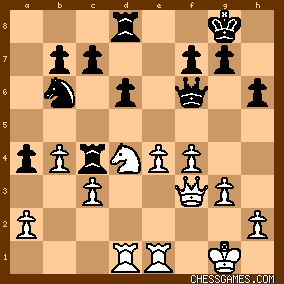
click for larger viewOne thing is certain, at this point, Tarrasch was in no objective danger here, the contrary suggestion by Reti notwithstanding. 24. Re3?
"?"--(Kasparov)
"?!"--(Soltis)
Tarrasch says that he should have defended the b-pawn with 24. a3. That would surely have left White with superior chances had Black replied sensibly (with, e.g., 24...Re8 or 24...Rc8 or 24...Rd7). And White would have been in even better shape had Lasker then played Tarrasch's suggested 24...c5?! which leads to major trouble for Black after 24. Nb5 cxb4 (perhaps 24...Qe7 is an improvement here) 25. cxb4. Solits aptly commented that: "Here is where White begins to go very wrong." Soltis then gave four better choices: 24. a3 (Tarrash's suggestion); 24. Qe3; 24. Rb1; and 24. Rd3. The latter three moves are well-covered in the post by <keypusher> But the line I really like, and which only <Calli> and <keypusher> (apart from a passing suggestion of this move by Wilson) seem to have considered is 24. e5. Play might then continued: 24...dxe5 [forced] 25. Rxe5 with excellent attacking chances. Bravo <Calli> and <keypusher>. After Tarrasch's feeble 24. Re3, Black was out of danger, the position now being: 
click for larger viewLasker knew what to do here:
24... c5!
"!"--(Lasker)
"Increases the effectiveness of the Rook at c4." (Schroeder) "A powerful reply to the threat [of 25. Nb5 and if then 25...c6 26. Na3] (Hoffer) Lasker's fine move left:
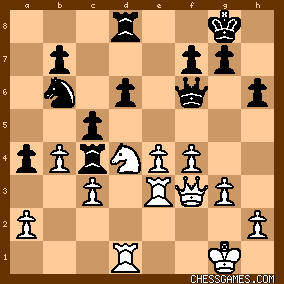
click for larger viewBad as his 24th move was, it was here that Tarrasch collapsed, courting serious trouble with his next move and then overlooking Lasker's combo entirely on move 26 and then getting blown off the board. Playing over the game there is no escaping the conclusion that Lasker saw more deeply into the position than did Tarrasch. |
|
Aug-03-23
 | | KEG: Post VII
25. Nb5?
"?"--(Tarrasch)(Soltis)(Kasparov)(Schroeder)(<Calli>) "Had I not been so determined on my idea of a Rook sacrifice, I would have by 25. Nc2 cxb4 26. Nxb4 still gotten an attack on the d-pawn, thus obtaining a good game." (Tarrasch as per <keypusher>). "Driven by a passionate desire to punish his opponent for his violation of the chess laws, Tarrasch 'goes off the rails.' " (Kasparov) "The text move is a blunder, but part of the subsequent faulty sacrifice." (Hoffer) "Tarrasch's nerves failed him in this match...Here he pins his chances on a [faulty--KEG] combination." (Soltis) "A serious mistake which costs the game." (Teichmann) Tarrasch's suggested 25. Nc2, though not leading to any advantage for White that I can see, looks good enough for approximate equalize. Also good for equality was the simple 25. bxc5 as originally recommended by Teichmann and Hoffer. Play might then have continued: 25...Rxc5 [not 25...dxc5 which Teichmann demonstrated would lose for Black] 26. Rb1 Nc4 27. Rd3 [or, instead of Teichmann's move, maybe 27. Re2). with equal chances. Tarrasch's move need not have cost him the game, but it definitely left Lasker with all the chances. 25... cxb4
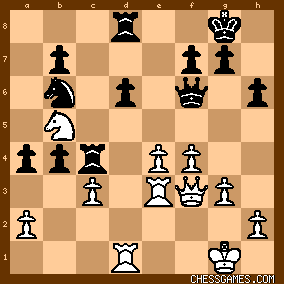
click for larger view26. Rxd6?
"?"--(Kasparov)(Tarrasch)
Kasparov and Soltis suggested that Tarrasch might have been able to muster a defense after 26. cxb4 Rxb4 27. Nc3, but as Soltis pointed out, "...[Tarrasch's] survival chances aren't great after 27...Rc8 [or after 27...Rb2--KEG]." The only real chance to save the game--and a good one it was--26. Red3. If then 26...bxc3, White seems to survive just fine with either 27. Nxc3 [with e5 to follow] or 27. e5. And if Lasker had responded with the stronger 26...d5! play might continue 27. e5 Qc6 28. Nd4 Qc8 29. cxb4 Rxb4 leaving White with decent play for the pawn. Lasker, of course, responded:
26... RxR
And then Tarrasch played the move on which he had erroneously been relying: 27. e5
"This was the point of Tarrasch's combination." (Lasker) "No doubt Dr. Tarrasch designedly adopted this line of play, but there is a flaw in the combination. (Hoffer) This left:
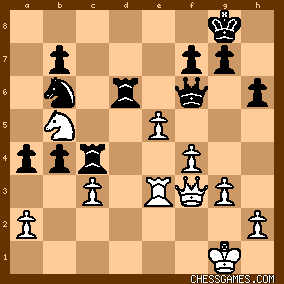
click for larger viewLasker later explained the fatal holes in the White position: "To understand the motifs of this combination one must dig deep. White is attacking Queen and Rook with his e-pawn; hence, both are desperados: they look for checks, for attack on the opposing Queen, for captures, for strong threats regardless of the sacrifice involved. 27...Re1+ suggests itself, but that check is adequately guarded by the White Queen. Here is the function motif holding the White Queen. The White Queen guards the f-pawn, which is also guarded by the g-pawn; and that g-pawn must guard against the check of the Black Queen. Considering the functions of the White Queen and the g-pawn, the White f-pawn is not defended at all." (Lasker) Given all this...Black to move and win.
The winning move here must have been a shock to Tarrasch. |
|
Aug-04-23
 | | KEG: Post VIII
27... Rxf4!
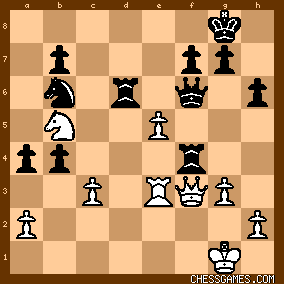
click for larger view"!"--(Lasker)(Schroeder)
"!!"--(Kasparov)(Soltis)
"This is what White overlooked"--(Lasker)(Soltis) "This ingenious reply had been overlooked by Tarrasch, and wins for Black." (Wilson) "The saving move, which Dr. Tarrasch evidently overlooked, and the game is lost." (Hoffer) "And here is the refutation. Moreover, by the irony of fate the fatal blow is struck by the abhorrent 'hooligan' rook!..."--(Kasparov) Indeed, after Lasker's brilliant retort, White is simply lost in all variations: 28. gxR
Everything else also loses.
If instead, 28. gxR, Black cruises with 28...Rd1+ 29. Kg2 (29. Kf2 is no better; 29... QxQ+ 30. gxQ b3 [even better than 30...Nd5 as given by Kasparov and Soltis, which wins almost as easily] 31. axb3 axb3 32. Re1 Rd2+ 33. Kf3 b2 34. Nd6 Nd5 35. Nb5 Rd3+ 36. Kf2 Rxc3! 37. NxR NxN and wins by Queening the b-pawn) 29...Rd2+ 30. Kg1 QxQ 31. gxQ b3 32. axb3 axb3 33. Re1 Nc4 34. Nd6 Na3 35. f5 [what else??] b2 and wins easily. Also hopeless is 28. exQ RxQ 29. Re8+ [or 29. RxR Rd5] Kh7 30. NxR b3 31. axb3 axb3 32. fxg7 Kxg7 33. Re1 Na4 and wins. If instead 28. Qe2 Rf1+ 29. QxR QxQ+ 30. KxQ Rd5 31. Nc7 Rd7 32. Nb5 b3 33. axb3 axb3 34. Na3 b2 and wins. After Tarrasch's 28. gxR, the position was:
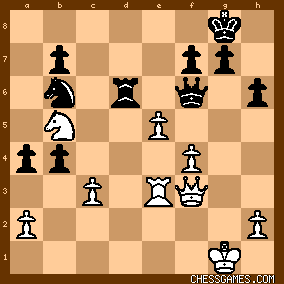
click for larger view28... Qg6+
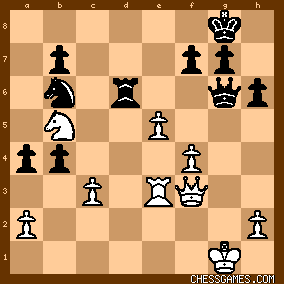
click for larger view29. Kh1
29. Kf1 gets crushed by 29...Nc4 [and not Kasparov's 29...Qb1+? which gives White a fighting chance: 30. Re1 Qd3+ 31. QxQ RxQ and now not Kasparov's hopeless 32. Ke2? which loses to 32...Rh3 but 32. cxb4 Nd5 33. Re4 Rd2 34. Re2 Re1+ 35. Re1 RxR+ 36. KxR Nxb4 and Black will not have an easy time winning the Knight and Pawn ending: 37. Nc3 Nd3+ 38. Kd2 Nxf4 39. Nxa4] Now back to the stronger line [29...Nc4 30. exR Nd2+ 31. Kf2 NxQ 32. RxN Qc2+ 33. Kg3 Qd1 34. Kf2 Qd2+ 35. Kg3 b3 36. axb3 axb3 and Black's Queen and passed b-pawn are far too much for the White Rook and Knight duo. 29. Kf2 is also hopeless after 29...Rd2+ 30. Re2 Rd1 31. Re1 RxR 32. KxR b3 33. axb3 axb3 34. Na3 Qg1+ 35. Kd2 Qa1 The balance was easy for Lasker, the position after 29. Kh1 being: 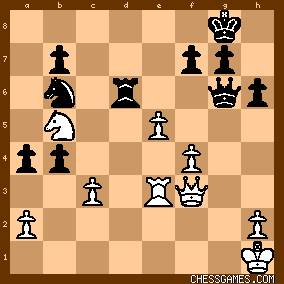
click for larger view29... Qb1+
30. Kg2 Rd2+
30...Rg6+ was a tad faster, but the text was also an easy win for Black, the position now being: 
click for larger view |
|
Aug-04-23
 | | KEG: Post IX
Lasker polished off the game briskly.
31. Re2
31. Kh3 Nd5 would have been no better.
31... Qxa2
32. RxR
32. Kf2 a3 (or 32...b3) would likewise be hopeless. 32... QxR+
33. Kg3 a3
"!"--(Soltis)

click for larger viewNot sure I understand the "!" from Soltis. The win is no longer difficult, and either 33..b3 or 33...Qe1+ would have been faster. Not that there was anything wrong with the text. 34. e6
Desperation!
34... Qe1+
34...fxe6 or the simple 34...a2 were probably faster. 35. Kg4
Further simplifying Lasker's task. But 35. Qf2 Qxe6 would not only extended the game a few moves. 35... Qxe6+
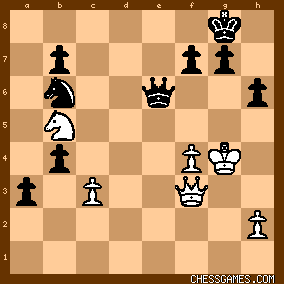
click for larger viewTarrasch might have spared himself the rest.
36. f5 Qc4+
37. Nd4 a2
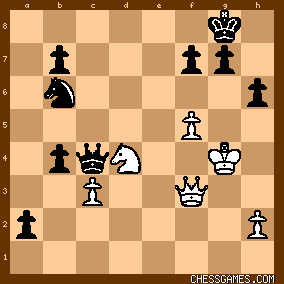
click for larger view37...b3 or 37...bxc3 were of course faster, but by now Lasker was likely merely awaiting Tarrasch's resignation. 38. Qd1 Nd5
Adding a murderous Knight-fork to his threats.
39. Qa4 Nxc3
40. Qe8+ Kh7
41. Kh5 a1(Q)

click for larger viewTarrasch had made a second Queen in defeating Lasker in Game 3 of the match. Lasker now returned the favor in this 4th game. 0-1 |
|
| Mar-09-24 | | DanLanglois: Much 'processing' here of Lasker's 15...Re5 and 16...Rc5, as if Lasker actually gets a good position out of this w/out relying on Tarrach's subsequent bad moves. What is actually most interesting to me is that Tarrash doesn't resign before he does. By the time he is two pawns down? And Lasker is pushing the passed a-pawn? And check, check, check? An expert player would resign, it wouldn't take an expert player even, to see the writing on the wall. You can't win by resigning, but I just find myself picturing this, I'm Tarrasch, my game is toast, I want to play this out?? It's what really gives the impression that Tarrasch was out of his league. 27. e5, Tarrasch is forking Lasker's Queen and rook: 
click for larger viewIt's not that great for White even if Black just plays 27...Qf5, but here is better, 27...Rxf4!! 
click for larger viewPoint is that after 28. gxf4, Black's queen gets out of danger with check 28...Qg6+: 
click for larger viewWhite can resign. |
|
 |
 |
|
< Earlier Kibitzing · PAGE 3 OF 3 ·
Later Kibitzing> |
|
|
|





































